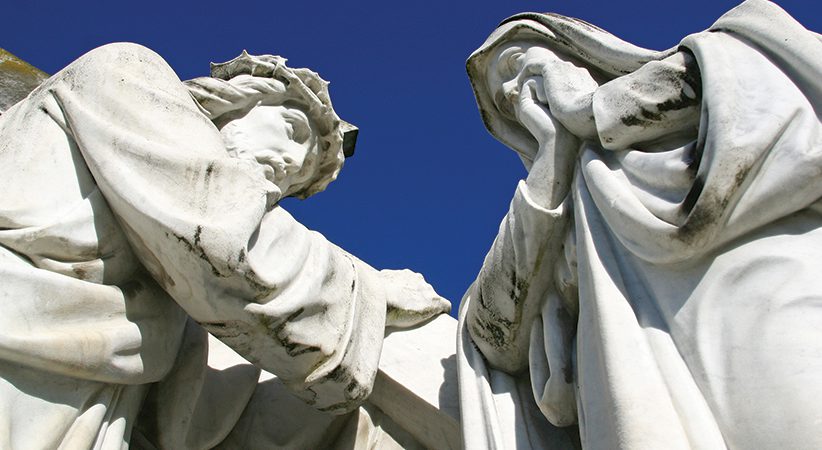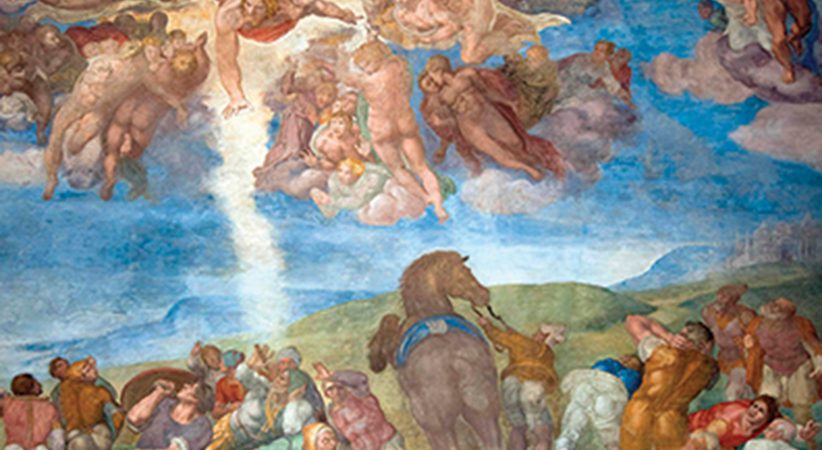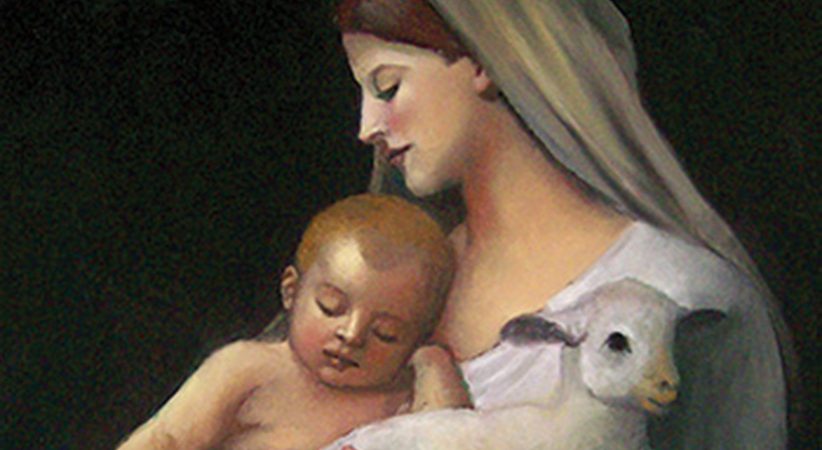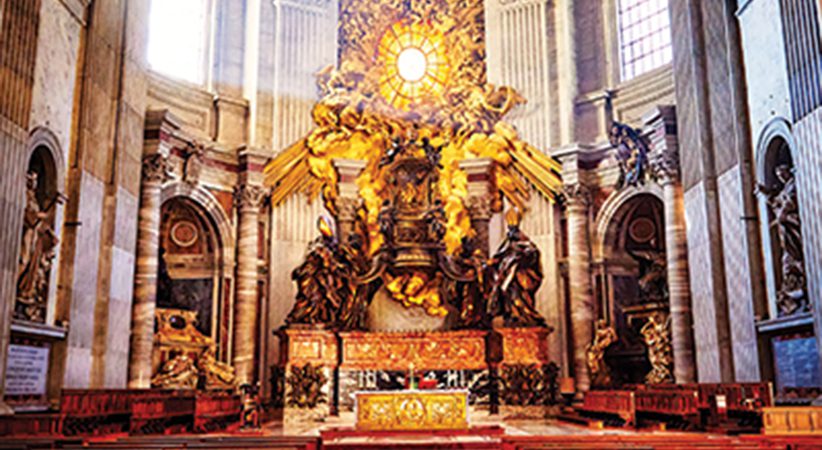Embracing the Sorrows of Life with Mary
How devotion to Our Lady of Sorrows can help us understand suffering and pain
Michael R. Heinlein Comments Off on Embracing the Sorrows of Life with Mary
October is a month dedicated to the Rosary — an opportunity to focus on the importance of Marian devotion in the life of the Church.
The spiritual maxim of St. Louis de Montfort sums up succinctly what has been reiterated since ancient times: Ad Jesum per Mariam (“to Jesus through Mary”). The fruit of Marian devotion is union with her divine Son. The Second Vatican Council’s dogmatic constitution Lumen Gentium states that the Church regards devotion to the Mother of God as important because she “occupies a place in the Church which is the highest after Christ and yet very close to us” (No. 54). The Church’s Marian devotion is well put in the words of Pope St. John Paul II’s 2002 encyclical Rosarium Virginis Mariae: “among creatures no one knows Christ better than Mary; no one can introduce us to a profound knowledge of his mystery better than his Mother” (No. 14).

There is, perhaps, no more beloved Marian devotion than the Rosary. A tradition holds that the Blessed Mother revealed the prayer form known and beloved today — sometimes referred to strictly as the “Dominican Rosary” — to the mendicant preacher St. Dominic. The Rosary offers an opportunity for meditative reflection on the mysteries of Christ’s life and Mary’s — and a prism through which to reflect on our own Christian lives.
Various popes and saints have spoken of the Rosary’s importance in one’s prayer life. And, of course, a century ago the Rosary gained fresh significance when the Blessed Mother beseeched the world at Fatima to pray it daily to obtain peace.
History of the Servite Rosary
Aside from the Rosary, other forms of Marian prayer, also called “rosaries” and sometimes called chaplets, have emerged in the life of the Church over the centuries. Notably among these is the Servite Rosary, also known as the Rosary of the Seven Sorrows or the Chaplet of the Sorrowful Mother. This prayer has been a part of the Church’s devotional life since the 13th century.
The history of the Servite Rosary is traced back to 1240, when seven young professional men retreated into the hills outside of Florence, Italy. Contemporaries of St. Dominic, they sought to establish a new religious order called the Servites, dedicated to a life of prayer, penance and service in the name of Our Lord and his Blessed Mother. They promoted devotion to Our Lady of Sorrows as an opportunity to venerate, alongside her crucified Son, his sorrowful mother (see Jn 19:25-27).
Through the ages, many saints also have worked to foster devotion to Our Lady of Sorrows, including St. Bridget of Sweden. In the 18th century, Redemptorist founder St. Alphonsus Liguori worked to foster devotion to the Blessed Mother, drawing fresh attention to the Mother of Sorrows. His famous series “The Glories of Mary” contains meditations on Mary’s sorrows, still popular today.
Importance of the Devotion
The Servite Rosary takes on the shape and form of the popular Rosary. Instead of the mysteries, there are seven sorrows in the life of Mary proposed for meditation. Along with opening and closing prayers unique to the devotion, the Servite Rosary ends with three Hail Marys, which represent Mary’s tears. And instead of reciting five decades of Hail Marys in a given set of mysteries of the Rosary, there are seven septets of Aves.
In many ways, this devotion helps one to reflect on his or her own personal sinfulness. Every human being who ever lived or will live is responsible for the crucifixion of Our Lord, as the Catechism of the Catholic Church states (see No. 598). Therefore, the heart of Mary’s sorrow is found in the harsh reality that her Son was born so as to die for our sins. Everything about his life aims toward the Cross. Indeed the entire Christ-event occurred to bring redemption — the forgiveness of our offenses against God. But not only do our sins damage or destroy our relationship with God, but sin affects the entirety of human solidarity (see CCC, No. 1872) and introduces realities such as suffering (CCC, No. 418). When we reflect on Mary’s sorrow, we come face to face with that reality; the Sorrowful Mother is sorrowful because of our sins.
In Scripture, seven occasions of intense sorrow and grief in Mary’s life are recorded. Devotions like the Servite Rosary enable devotees of Mary’s sorrows to encounter the many facets of human grief and sorrow that were part of the Blessed Mother’s life.
Devotion to Mary’s sorrows affords the opportunity to ponder her who is “full of grace” and chosen by God to be his mother. Chosenness often is associated with something exceptional and honorable, especially if God is the chooser. Devotion to Our Lady of Sorrows helps us to remember that the favor God shows us is not immune from suffering. Just as Mary was chosen by God to be an integral part of salvation history, meditating on her experiences of grief and sorrow allows us to understand that God is alive and active even in those same experiences in our lives. In Mary’s suffering we can find a way to understand our suffering. What follows are the Seven Sorrows of Mary and some reflections to assist in meditating on this reality.
Simeon’s Prophecy
The first sorrow, in many ways, lays the foundation for the others. New parents know the joy and awe that surrounds the first months after a child is born, particularly with the firstborn. Forty days after giving birth, when Jesus is just less than 6 weeks old, Mary and St. Joseph bring him to be presented to God at the Jerusalem Temple (see Lk 2:22-24). This act of worship and thanksgiving, customary for the parents of any first-born Jewish male, was presumably a day of joy for the young mother. Her joy was turned to amazement, St. Luke says in his Gospel, when the prophetic Simeon acknowledged Jesus to be Israel’s long-awaited Messiah. And yet, in the midst of her joy, a curtain falls when Simeon declares, “Behold, this child is destined for the fall and rise of many in Israel, and to be a sign that will be contradicted (and you yourself a sword will pierce) so that the thoughts of many hearts may be revealed” (Lk 2:34-35). This sorrow illustrates how God’s ways are not our own; joy and sorrow are intertwined to achieve God’s purposes. For this reason, Mary willingly and lovingly embraced all her sorrows and sufferings even when she embraced God’s plan for her at the Annunciation.
Fleeing to Egypt
Immediate action was taken by St. Joseph following the stark warning he received in a dream (see Mt 2:13). It was necessary to deliver the Christ Child from the threats of murderous Herod, who sought to slaughter the newborn king he heard about from the Magi. St. Joseph guided his holy family to Egypt, as the Lord’s angel had directed. The joy of Mary’s motherhood is crushed further as the Holy Family must take on status as émigrés. As a loving mother, Mary must now be strong for her divine Son in the face of hardship and uncertainty.
Jesus, Mary and Joseph become strangers in a strange land. The Holy Family put their trust in God, not knowing the next steps of his plan. And in doing so they teach us how to turn pain into an act of faith and prayer.
Losing Jesus in Jerusalem

When Jesus was 12, the Holy Family made a pilgrimage to Jerusalem for the Passover (see Lk 2:41-52). On the return home, the Christ Child’s parents thought he was with the caravan returning to Nazareth. When they came to find he was not with anyone, they broke away from the caravan and returned to the city to look for Jesus — symbolically searching for three days. A parent cannot imagine the grief that would have its clutches on the human heart in such a moment. Undoubtedly the self-doubts and self-blame were surely paralyzing. What does Mary think when she finds Jesus in the Temple? Readers learn of no practical explanations for this event in the Gospel. Could Jesus have told someone about his plan, and the news did not reach his holy parents? Was he just an obnoxious teenager who chose to do his own thing? It seems these options are not the case. Rather, it is made clear that Jesus is single-hearted in doing God’s will already in his youth. Here Jesus models primacy of obedience to God’s will, which often can leave others amazed and afraid, as he did years later with the apostles (see Mk 10:32). Mary no doubt pondered mysterious and awesome occasions like this in her heart (Lk 2:19), wrestling to discern their purpose — never gaining full clarity until years later at the cross.
Meeting Jesus on the Via Dolorosa
The Gospels do not tell us when Jesus would have seen his mother for the last time. In fact, we are not told much about her at all during Jesus’ public life and ministry. And, in this fourth sorrow, Mary encounters her beaten and bloodied Son as he makes his way to the site of his execution. Imagine Mary’s shock when she learned of her Son’s unwarranted arrest and the death sentence following his mock trial at Pilate’s praetorium. What must it have been like for Mary? She knew her Son was conceived by God’s power, and yet he is subjected to the most humiliating, degrading and unjust of human experiences. Here, Mary witnesses for us what it is like to trust in God, even when it seems as if there is no reason to do so. She is unafraid to accompany her Son to his death, modeling for us that love of God should matter above all else. Here we learn from the “school of Mary” that in our grief, like in that of Mary, our primary concern in all things should be her Son.
Jesus Expires on the Cross
St. John’s Gospel states that Mary was standing at the foot of Jesus’ cross (see 19:25). And this is not a minor detail. As is the case with cultural and societal norms, there would have been expectations for how a woman in Mary’s situation would have acted and behaved. Public displays of grief were not uncommon, perhaps even expected. Mary should have been flailing around in misery at the execution of her Son. But what would that have proven? Such grief would have been a slap in the face to God. Such behavior would have been a denial of God’s plan. Standing was a sign of strength and determination. By standing at the cross, Mary is showing to all around — and us as well — that she knows that her Son’s death is not the end of his story. Mary is an icon of faith at the cross, but that does not take away her sorrow. It does not take away the pain of watching her Son gasp for breaths and speak his final words. It does not take away the fleeting moments of doubt that can plague the minds of even the greatest saints. In the end, Jesus was not alone in his suffering at Calvary. His was not the only heart pierced with a sword there. Mary’s was, too, albeit figuratively, fulfilling Simeon’s prophecy.
Jesus Is Taken from the Cross

A mother has untold hopes and dreams for the babe she cradles in her arms. Mothers never are supposed to find those dreams to be dashed, similarly holding her child’s lifeless body in her arms. That is an incomparable grief — a finality no mother ever imagines possible. What makes it worse is that Mary’s Son is executed. There is nothing natural about his death, as if that would make matters any better. But given the circumstances, there is all the more possibility for hatred to occupy the heart. And yet for Mary it does not. Michelangelo’s famous sculpture of this sixth sorrow is one of the most recognizable pieces of art in Christendom — the Pietà. In his portrayal of this event, Mary appears very young, perhaps even younger than her lifeless Son. That is an illustration of her purity — as the immaculate one there is nothing of the sin and evil that only corrupts. Rather, as if in prayer, Mary gives thanks for her Son. She has faith in God’s plan, living in the hope of God’s promise. Here, Mary knows only love as she gazes on him who just performed love’s greatest act. Mary shows humanity that it is possible to live in a way that is contrary to all the instincts directed by sin. Here, in her sorrow, Mary transforms hate into love by mirroring her Son.
Jesus Is Buried
Jesus and Mary are of simple means. As his sole surviving family member, Mary is unable to provide her Son a grave. In humility, she must depend on the charity of many, such as St. Joseph of Arimathea, who gives up his own grave for Jesus’ use. And Mary and the other women presumably want to do nothing more than to attend to the body of their beloved Jesus. But as Jewish laws require, they must wait until the Sabbath is over.
| ‘Why the Rosary, Why Now?’ |
|---|
|
As the Church celebrates the Rosary
during October, Gretchen R. Crowe,
editor-in-chief of Our Sunday Visitor,
explains why the Rosary should be
an essential part of every Catholic’s
life. For more information, or to order,
visit OSVcatholicbookstore.com.
|
Burial has attached to it all the connotations of life’s final curtain call. There is no way around it. Many families today opt for more cosmetic burials of their loved ones, choosing to say their last farewells — if burial is even chosen — in the comfort of a cemetery chapel rather than at the cold, stark graveside. It makes the loved one’s death all too real. The full weight of what happened on that Good Friday must have weighed immensely on Mary at that moment. But is death a problem to be avoided or a step in the soul’s life to be embraced?
This sorrow is presumed of the Gospel accounts of Jesus’ burial and kept alive by tradition. Mary shows us that burial is an opportunity to live as an icon of hope. Rather than allowing herself to be crippled by despair, despite the anguish and pain, Mary accompanies her Son’s body to the finality of the grave. Mary witnesses to the hope that should be ours as we each bid farewell to our loved ones, assured by the hope of the resurrection of the body we profess to believe.
Mary’s hope indicates that within her heart there is a glimmer of the joy that awaits her on Easter morning, when her tears will be turned into the dancing promised by the psalmist (see 30:12) because God is faithful.
MICHAEL R. HEINLEIN is editor of OSV’s The Catholic Answer. Email him at mheinlein@osv.com. Follow him on Twitter @HeinleinMichael.
………………………………………………………………………………………………………………………………………………………
The Seven Graces

In the 14th century, St. Bridget of Sweden received a vision of the Blessed Mother in which Mary promised graces to those who daily spent time meditating on her seven sorrows. Those graces are:
◗ I will grant peace to their families.
◗ They will be enlightened about the divine mysteries.
◗ I will console them in their pains, and I will accompany them in their work.
◗ I will give them as much as they ask for as long as it does not oppose the adorable will of my divine Son or the sanctification of their souls.
◗ I will defend them in their spiritual battles with the infernal enemy, and I will protect them at every instant of their lives.
◗ I will visibly help them at the moment of their death; they will see the face of their Mother.
◗ I have obtained from my divine Son that those who propagate this devotion to my tears and dolors will be taken directly from this earthly life to eternal happiness since all their sins will be forgiven and my Son and I will be their eternal consolation and joy.
Source: TheMostHolyRosary.com
……………………………………………………………………………………………………………………………………………………….






